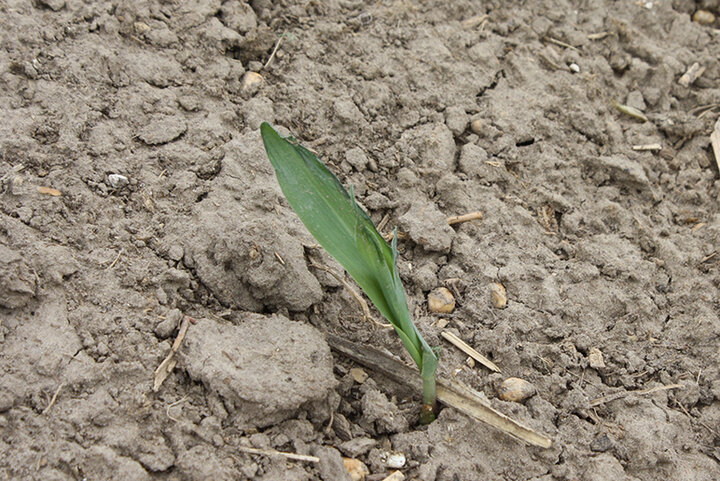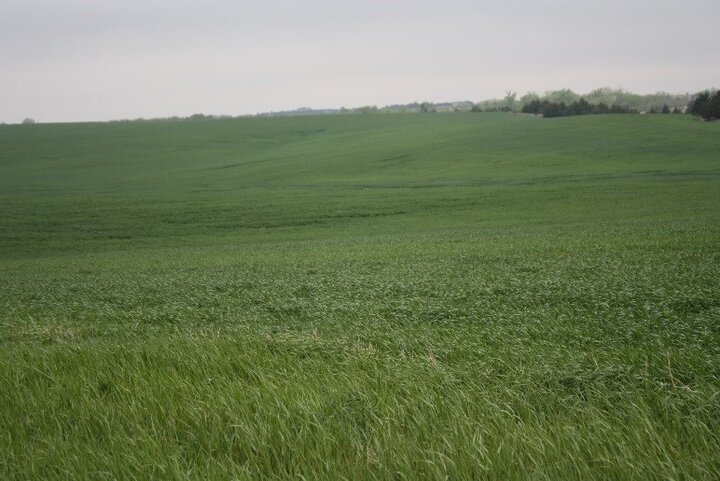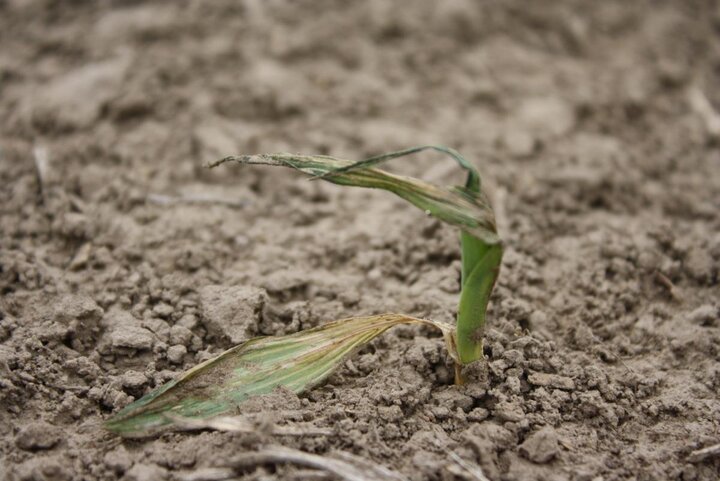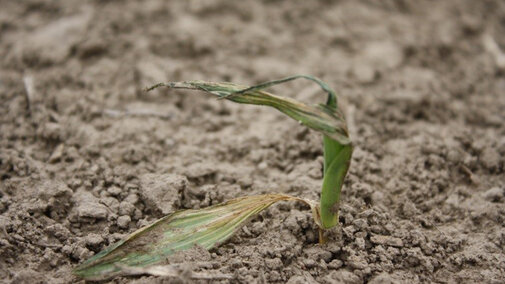

Ron Seymour, Extension Educator, with a field survey of southwest Adams County: About 70% of field corn has been planted and of that about 50% has emerged. Newly emerged plants were damaged by a weekend thunderstorm with high winds (Figure 1). The damage was particularly evident in field corn planted after soybeans or in tilled fields. About 30% of soybeans have been planted and only a few fields have emerged.
Wheat is jointed and, depending on soil moisture conditions, ranges in height from 4 to 12 inches (Figure 2). While most of the fields are not wilting, soils are dry and plant development is being limited. No wheat diseases were found at this time. Alfalfa is 6 to 12 inches tall and looks good. A few alfalfa weevils, lygus bugs, and pea aphids were found, but infestations were not sufficient to be of concern. (5/11/2018)
Amit Jhala, Extension Weeds Specialist: There have been some reports of fomesafen injury in corn, typically in fields where soybean was planted in 2017 and fomesafen-based herbicides such as Reflex or Flexstar were applied postemergence prior to a dry period. If corn was planted last year or soybean was planted but fomesafen-based herbicides were not applied, similar-appearing plant damage would not be from herbicide carry-over, but more likely would be from other causes, such as wind or storm damage. I saw a lot of fomesafen carryover injury in corn in Nebraska in 2013 following the 2012 drought, but have not seen much in the last three years. Most fomesafen-based herbicides are not labeled for use west of US 281 where conditions are drier and might contribute to herbicide carryover issues. (5/18/18)
Nathan Mueller, Extension Educator in Dodge County: We got quite a bit of rain in early May and more over the weekend. Corn planting is 80-90% done with 20% emerged; soybean planting is 50% complete. Alfalfa is taking off. Those raising high quality alfalfa will likely be mowing soon. I haven’t heard of any insects in alfalfa and have surveyed wheat, but not found any insects or diseases. With wet weather we may start to see diseases develop in wheat. (5/15/18)

John Wilson, Extension Educator in Burt County: Planting is progressing nicely. We got an inch or more of rain over the weekend, depending on location, which was praised by those with soil crusting problems and those needing to activate herbicide, but cursed by those still planting. We had some crusting from the hard rains about 10 days ago; little showers from time to time since then have lessened that problem. (5/15/18)
Thomas Hunt, Extension Entomologist, Northeast District: We’re wet here and planting is behind. If it stays dry a day or two, they’ll hit planting again hard. I went out on an alfalfa tour last week, looking for insect pests, but didn’t find any at worrisome numbers. I will survey another section this week. (5/15/18)
Jenny Rees, Extension Educator serving in York, Seward, Clay, Nuckolls, Thayer, Fillmore counties: Some growers are still planting, but much has been planted and a lot of corn and soybean have emerged. Wheat is from elongation to boot stage and showing a lot of moisture stress. Some growers are cutting it for silage or hay and some are making wheatlage (wheat silage). There’s some powdery mildew in the lower canopy and some aphids. I’m not seeing any insects in the alfalfa. With last week’s high winds and blowing soil, we saw plants cut off at ground level. We’re seeing some regrowth on damaged plants, but some end rows will likely need to be replanted as plants are buried under piles of eroded soil. (5/15/18)
Tyler Williams, Extension Educator in Lancaster County: Planting progressed quickly with almost all the corn and most of the soybeans in. We’ve gotten enough precipitation to activate herbicides. We don't have a lot of wheat, but there have been reports of some yellow areas. (See related CW story) (5/15/18)
Megan Taylor, Extension Educator, reporting for Platte, Boone, and Nance counties: I looked at alfalfa in my area and found some alfalfa weevils. The crop looks really strong and some will be cutting by the end of next week if it dries out. Lindsey got 1.4 inches of rain on Monday; Columbus got 0.4. Corn and beans look good with strong emergence. I’ve seen some planter errors where they’re not getting the drill set correctly, leaving a lot of soybeans on the ground. Planting in the area is almost done. (5/15/18)
Steve Melvin, Extension Educator in Merrick County: Some are done with planting, but a few are still going. We got some rain Friday that stopped planting. Wheat, alfalfa, and cool season grasses in pastures will be really short this year. Shorter wheat shouldn’t affect wheat yield too much and may be a benefit as the wheat may not fall down as much. Pastures are the biggest problem this spring. There’s just not much growth. The dry cool conditions have really showed down early growth.
Troy Ingram, Extension Educator in Howard County: We got almost 1.5 inches of rain in the last week, with quite a bit of erosion in the hills. Approximately 60%-70% of the corn has been planted and less than 50% of the beans. Yesterday we got another 0.35 inch of rain. Custom applications are falling behind due to the rain. A couple hay fields have been cut. We also have a lot of short pasture this year.
Todd Whitney, Extension Educator in Phelps County: I'm seeing a lot of variability in rain amounts in this area. North of town there was 2-2.5 inches of rain in the last week and a half, and just west of town, a pivot was running. The northern part of the county has gotten some pretty good rains. Wheat is two weeks behind in development and those who would have been putting up wheatlage (wheat silage) are now wondering if they’re going to need to buy some resources for their feedlots. We’ve seen a few alfalfa weevils. Almost all the corn has been planted; some hasn’t emerged yet while some is at the third-leaf stage. About 60%-70% of the soybeans have been planted and 50% of the sorghum.

